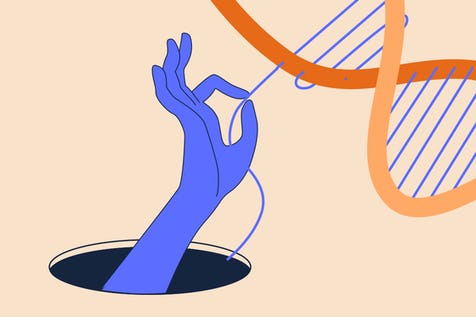Uterine fibroids are tumours that grow in your uterus. Upon hearing the word "tumour," you may wonder if these abnormal growths are cancerous. Fortunately, uterine fibroids are typically non-cancerous, which means they seldom develop into cancer [1].
Uterine fibroids mainly affect people in their reproductive years, and research studies have estimated that up to 80% of people will experience this condition during their lifetime [2].
Although extremely common, uterine fibroids often go undiagnosed because most people with this condition do not notice any symptoms at all. A smaller group of people may have severe and painful symptoms that beckon them to seek medical attention [2].
In this article, we'll explore the causes, symptoms, and treatment for uterine fibroids. We'll also look into how this condition may affect your fertility and menstrual cycle.
Let's dive right in.
What Are The Different Types Of Uterine Fibroids?
The type of uterine fibroid a person has is classified based on its location. According to the National Health Service (NHS), the main types of fibroids that exist based on location are as follows [3]:
-
Subserosal: This term refers to fibroids that form on the outside of the uterus.
-
Intramural: These fibroids develop within the muscular wall of the womb.
-
Submucosal: Submucosal fibroids appear just beneath the inner lining of the uterus.
Fibroids may vary not only in terms of the location they appear but also in size and number. For instance, fibroids can range widely in size, from the size of a tiny seedling, barely detectable by the human eye, to larger growths as large as a melon, which can cause your belly to visibly bulge [1, 4].
Additionally, some people may just have a single fibroid, while other patients may have multiple fibroids, even more than 60 in some instances [1].
Symptoms Of Uterine Fibroids And How To Detect Them
Many people with uterine fibroids will not experience any symptoms, but an estimated 30% of people will present with symptoms severe enough to warrant medical treatment [2].
Let's take a look at the common symptoms of uterine fibroids and how this condition is typically diagnosed.
What are the symptoms of uterine fibroids?
Some symptoms of uterine fibroids include [1, 2]:
-
Heavy periods
-
Painful periods
-
Periods that last longer than normal
-
Pelvic pain
-
Back pain
-
Increased urination
-
Constipation
-
A feeling of fullness or bloatedness in your abdomen
-
Swollen abdomen that looks bigger than usual
If you experience the above fibroid symptoms, it's best to get them checked out by your healthcare professional.
Some people may also develop emotional distress, depression, and anxiety due to uterine fibroid symptoms, which have significantly affected their quality of life [2].
Understandably, the emotional impact of uterine fibroids can be heavy, so this shouldn't be swept aside. It's always best to seek professional advice from a healthcare professional if you find that your symptoms are affecting your mental wellness, too.
Can uterine fibroids cause anaemia?
Yes, uterine fibroids can lead to iron-deficiency anaemia, as this condition is commonly associated with heavy and prolonged menstrual periods [2]. Heavy or prolonged periods can lead to more blood loss than normal, which may deplete your body's iron stores in the long run and contribute to iron-deficiency anaemia.
How are uterine fibroids diagnosed?
Your doctor will likely evaluate your symptoms and perform a pelvic exam to check the condition of your uterus. In the case your doctor suspects that you have uterine fibroids, an ultrasound scan may be performed to confirm the diagnosis [5].
You may undergo a transvaginal ultrasound, which is roughly 90% to 99% effective for detecting uterine fibroids. This procedure involves the insertion of an ultrasound wand into the vagina to attain clearer images for diagnosis [5].
Some people with no symptoms may discover they have fibroids during routine gynaecological checkups or examinations.
What Causes Uterine Fibroids?
To this day, scientists and experts still do not know the exact cause behind uterine fibroids. However, changes in estrogen and progesterone levels and genetic factors are thought to play a role in the development of this condition [1].
A few risk factors may also increase your chances of developing uterine fibroids. They are as follows [1, 5]:
- Older than 40 years of age
- African ancestry
- Having a family history of uterine fibroids (meaning a relative of yours has the condition)
- Living with obesity
- Getting your first period at a very young age (younger than 10 years old)
- Have never been pregnant or given birth
- Vitamin D deficiency
Can Uterine Fibroids Become Cancerous?
Uterine fibroids are widely known to be non-cancerous growths. They are also very unlikely to increase your risk of uterine cancer [6].
According to the Office on Women's Health (U.S. Department of Health and Human Services), a cancerous fibroid may develop in extremely rare cases, and this is termed leiomyosarcoma. But experts believe that pre-existing fibroids do not bring about these cancers, so your risk of cancer isn't raised if you currently have uterine fibroids [7].
Uterine Fibroids And Pregnancy
Uterine fibroids may affect your reproductive health in various ways. In this section, we'll explore the impact of uterine fibroids on your menstrual cycle, fertility, and pregnancy.
Uterine fibroids and the menstrual cycle
If you've noticed changes or abnormalities in your cycle and bleeding patterns, this may be a symptom of uterine fibroids.
Uterine fibroids may lead to abnormal bleeding patterns, including heavy menses, spotting, clotting, and prolonged periods. Dealing with unexpected blood stains and the additional costs of menstrual products may lead to stress and embarrassment in some people with those symptoms [1].
How do uterine fibroids affect fertility?
Infertility refers to the inability to become pregnant after having regular unprotected sexual intercourse for at least 12 months. According to research, fibroids may be solely responsible for causing infertility in around 2-3% of people [8].
However, not all types of fibroids may significantly impact your fertility. Fibroids that project to the outside of the uterus (subserosal fibroids) are less likely to lead to infertility. On the other hand, fibroids that develop within the muscular wall of the uterus (intramural fibroids) or just under the inner lining of the uterus (submucosal fibroids) can put you at a higher risk of experiencing infertility [8].
These fibroids may distort the structure and function of your uterus, making it more difficult for a viable fertilised egg to implant itself on the uterine wall and start a pregnancy [7].
Do fibroids cause complications during pregnancy?
Research suggests that people with fibroids have a higher risk of experiencing complications during pregnancy [9].
These complications may involve the following [9]:
- Placental abruption: This happens when the placenta partially or fully separates from the wall of the uterus before delivery, which can reduce the supply of oxygen and nutrients to the baby.
- Birth defects: Bigger fibroids may increase the risk of birth defects. These include having shorter limbs, an abnormally shaped skull (dolichocephaly), or the twisting of the neck that causes the head to tilt at a strange angle (torticollis).
- Difficult labour and delivery: Fibroids may distort the form and structure of the uterus, which may lead to the unusual positioning of the baby as birth approaches.
- Labour dystocia: Labour dystocia refers to the abnormally slow progression of labour.
- Higher rate of miscarriages: This refers to pregnancy loss before 20 weeks of gestation.
If you have any concerns about the impact of fibroids on your fertility, sexual health, or pregnancy, it's best to get them addressed by your healthcare professional.
Uterine Fibroids Treatment And Prevention
The main treatment methods for uterine fibroids are medications and surgery. The optimal treatment regimen for your case will depend on a few factors, such as [5]:
- Whether your condition is symptomatic or shows no symptoms
- Whether you have reached menopause
- Whether you wish to preserve your fertility or your uterus
- The size, number, and location of your uterine fibroids
Let's explore the different types of treatments available for uterine fibroids.
Your doctor may recommend a medication to treat your uterine fibroids, which may include any of the following [5]:
- Non-steroidal anti-inflammatory drugs (NSAIDs) to help manage pain and reduce blood loss
- Birth control, which may help to stabilise the uterus and reduce blood loss
- Gonadotropin-releasing hormone (GnRH) agonists, which are medications that can be administered via a nasal spray to reduce the size of your tumours and decrease blood loss
- Tranexamic acid, an oral medication with antifibrinolytic effects, which helps to reduce blood loss.
Uterine fibroid surgery may involve any of the following procedures [5]:
-
Hysterectomy: This refers to the removal of the uterus through surgery and may be an option for people who do not wish to preserve their fertility.
-
Myomectomy: If you wish to preserve your fertility, your doctor may recommend a myomectomy, where the uterine fibroids are removed while the uterus is left intact.
-
Uterine fibroid embolisation: People who wish to preserve their uterus may undergo this procedure. It involves the injection of a substance into uterine arteries to block the blood supply to the fibroids, making them shrink.
-
Myolysis: This minimally-invasive procedure involves destroying uterine fibroids using heat, laser, or magnetic resonance-guided focused ultrasound surgery (MRgFUS).
There are no current clear strategies for preventing fibroids since their exact cause is still poorly understood.
However, living with obesity and insufficient intake of fruits, vegetables, and vitamin D may be associated with an increased risk of fibroids. Hence, maintaining a balanced diet and healthy weight might help to reduce your risk of fibroids, though more research needs to be done to confirm this [5, 10].
Final Takeaway: Uterine Fibroids Symptoms and Treatment
Uterine fibroids may lead to irregular bleeding patterns, prolonged bleeding, and painful periods. Hence, keeping track of your cycle helps you better understand your usual menstrual patterns and detect any abnormal changes quickly.
One device that can do just that is the inne minilab. This at-home cycle-tracking device harnesses the convenience and ease of daily saliva tests. Ultimately, the minilab helps you track your bleeding patterns, frequency, and length and detect any irregularities, allowing you to seek medical advice and receive timely treatment if necessary.
References
-
Aninye, I. O., & Laitner, M. H. (2021). Uterine Fibroids: Assessing Unmet Needs from Bench to Bedside. Journal of women's health (2002), 30(8), 1060–1067. https://doi.org/10.1089/jwh.2021.0280
-
Giuliani, E., As‐Sanie, S., & Marsh, E. E. (2020, February 17). Epidemiology and management of uterine fibroids. International Journal of Gynecology &Amp; Obstetrics, 149(1), 3–9. https://doi.org/10.1002/ijgo.13102
-
National Health Service. (2022b, September 14). Fibroids. nhs.uk. https://www.nhs.uk/conditions/fibroids/
-
Viva, W., Juhi, D., Kristin, A., Micaela, M., Marcus, B., Ibrahim, A., & Dirk, B. (2021). Massive uterine fibroid: a diagnostic dilemma: a case report and review of the literature. Journal of medical case reports, 15(1), 344. https://doi.org/10.1186/s13256-021-02959-3
-
De La Cruz, M. S., & Buchanan, E. M. (2017). Uterine Fibroids: Diagnosis and Treatment. American family physician, 95(2), 100–107.
-
Yuk, J. S., & Kim, M. (2022, July 1). Long-term risk of uterine malignancies in women with uterine fibroids confirmed by myomectomy: a population-based study. Journal of Obstetrics and Gynaecology, 1–6. https://doi.org/10.1080/01443615.2022.2091925
-
Uterine fibroids | Office on Women’s Health. (n.d.). Retrieved 17 October 2022, from https://www.womenshealth.gov/a-z-topics/uterine-fibroids
-
Freytag, D., Günther, V., Maass, N., & Alkatout, I. (2021). Uterine Fibroids and Infertility. Diagnostics (Basel, Switzerland), 11(8), 1455. https://doi.org/10.3390/diagnostics11081455
-
Tîrnovanu, M. C., Lozneanu, L., Tîrnovanu, Ş. D., Tîrnovanu, V. G., Onofriescu, M., Ungureanu, C., Toma, B. F., & Cojocaru, E. (2022). Uterine Fibroids and Pregnancy: A Review of the Challenges from a Romanian Tertiary Level Institution. Healthcare (Basel, Switzerland), 10(5), 855. https://doi.org/10.3390/healthcare10050855
-
Tinelli, A., Vinciguerra, M., Malvasi, A., Andjić, M., Babović, I., & Sparić, R. (2021). Uterine Fibroids and Diet. International journal of environmental research and public health, 18(3), 1066. https://doi.org/10.3390/ijerph18031066

.jpg)





